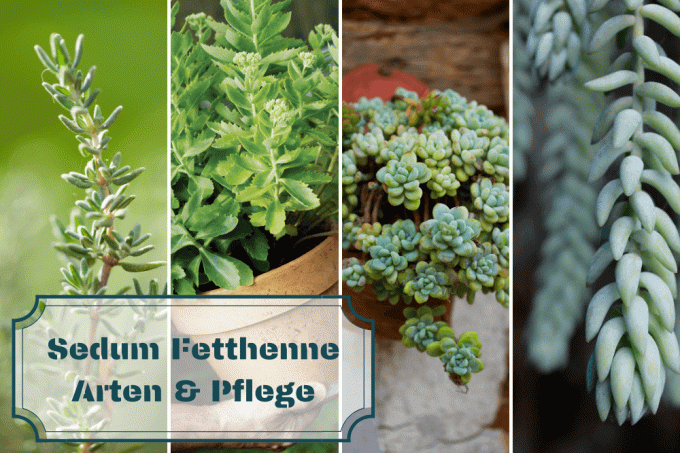
table of contents
- Sedum species
- Hybrid varieties
- The care
- The site
- Planting
- The pouring
- The cut
- Overwinter
- Fertilize
- The increase
- Diseases and pests
Sedum plants are considered to be the most species-rich plant genus from the thick-leaf plant family. In rock gardens, on green roofs, or in decorative plant troughs, it is very popular as an easy-care, exotic-looking plant. Below we introduce popular types of sedum plant and explain simple steps to take care of them.
Sedum species
The number of the individual Sedum species is given differently depending on the source, with 420 to around 600 species. Of course, not all of them have established themselves for use in the home garden, but there is still a large variety of usable varieties:
Gold sedum (Sedum floriferum)
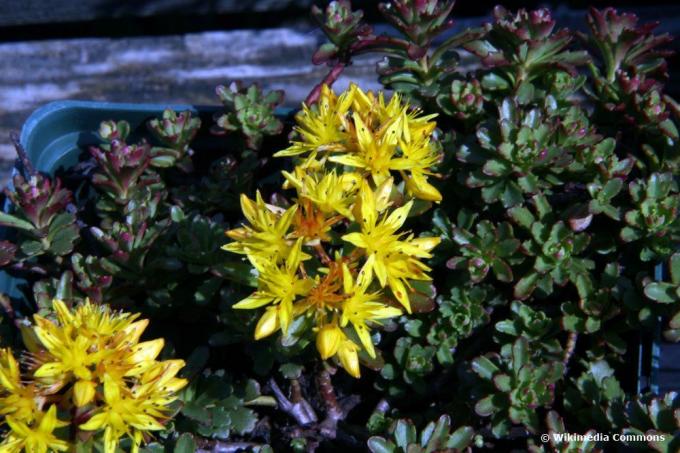
- Growth height up to 15 centimeters
- Forming mats
- evergreen
- Blooms in June and July
- golden yellow flower color
Gold tripmadam (Sedum reflexum)
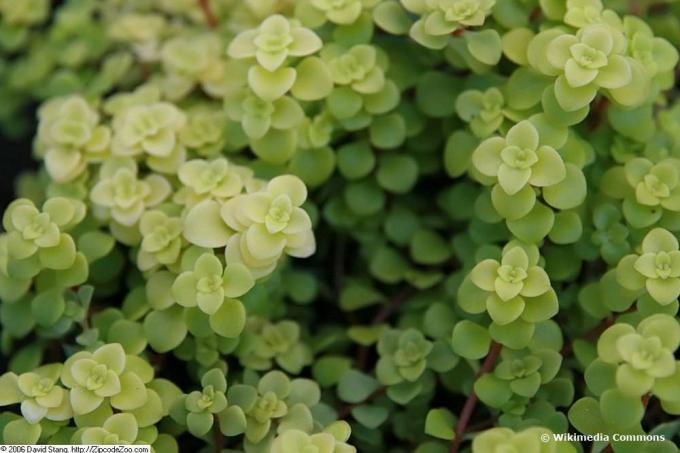
- Growth height up to 20 centimeters
- ground covering growth
- yellow flower color
- Flowering period June to August
- impressive autumn leaves
- Use as an aromatic herb for salads etc. possible
Caucasian stonecrop (Sedum spurium)

- Height of growth only 10 centimeters, but rapid growth in width
- evergreen and matting
- easy to grow and particularly easy to care for
- well suited as a ground cover
Purple sedum (Sedum telephium)

- Growth height around 20 to 30 centimeters
- Forming groups
- moving in in winter
- characteristic, purple flower color
Beautiful sedum (Sedum spectabile)
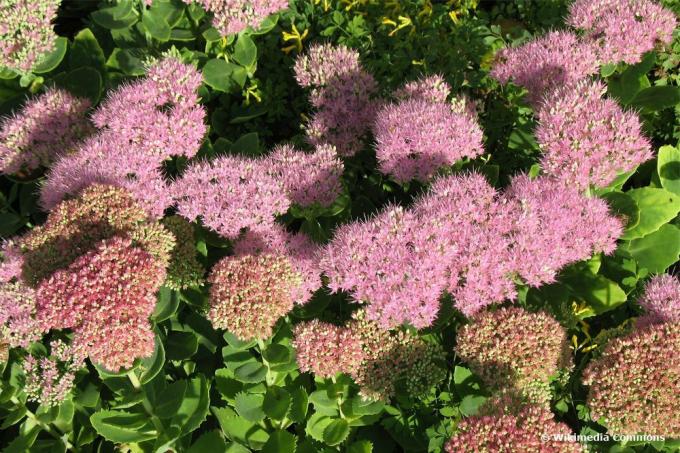
- Growth height up to 45 centimeters
- thriving in groups
- late blooming from July to September
- pink, star-shaped flowers
- moving in in winter
Snake sedum (Sedum morganianum)

- Height or Vine length up to 90 centimeters
- suitable for traffic light planting because of the extreme development of shoots
- pink flowers
- not hardy
Hybrid varieties
In addition to these widespread, original species of stonecrop, hybrid breeds in particular have become widespread in the home gardens. The common hybrids all go back to the species of the purple sedum telephium and are clearly similar to it in terms of rearing and care. Common hybrids are, for example:
Abbeydore
- Height: 45 centimeters
- Growth habit: upright
- Flowering period: August to September
- Flower color: light pink
- Foliage color: blue-green, later purple
Bertram Anderson

- Height: 25 centimeters
- Growth habit: creeping
- Flowering period: June to August
- Flower color: pink-violet
- Foliage color: dark purple
Beth's special
- Height: 50 centimeters
- Growth habit: upright
- Flowering period: August to October
- Flower color: brownish pink
- Foliage color: blue-green
Joyce Henderson
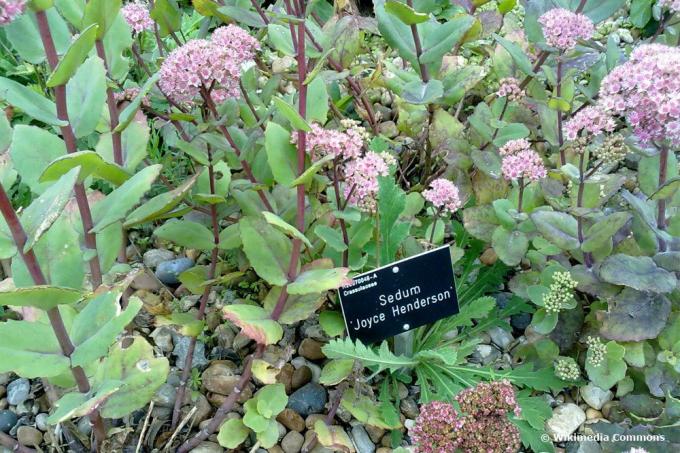
- Height: 80 centimeters
- Growth habit: upright
- Flowering period: August to September
- Flower color: pale pink
- Foliage color: purple
Carbuncle stone (Xenox)
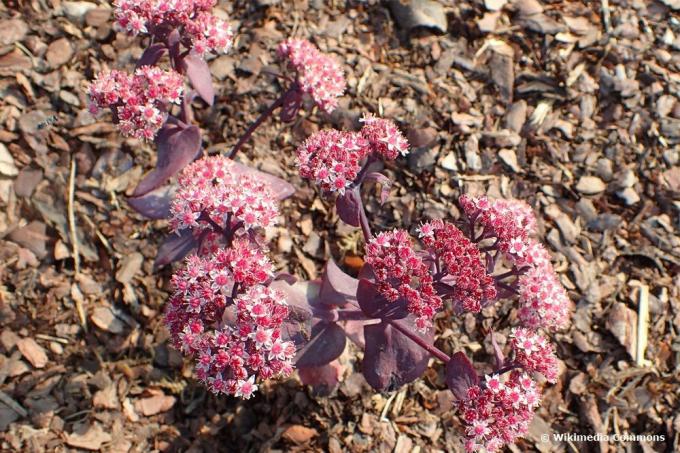
- Height: 50 centimeters
- Growth habit: upright
- Flowering period: August to September
- Flower color: brownish pink
- Foliage color: dark purple
Matrona

- Height: 60 centimeters
- Growth habit: upright
- Flowering period: August to September
- Flower color: pink
- Foliage color: olive green
Red cauli

- Height: 30 centimeters
- Growth habit: compact
- Flowering period: August to September
- Flower color: red
- Foliage color: blue-green, later dark red
The care
Once you have decided on a type of stonecrop, you need the right care if you want to enjoy this interesting plant over the long term. Overall, all varieties of this genus are very easy to care for and uncomplicated.
The site
With regard to their preferred location, the sedum plants are very diverse and broadly based. A wide variety of areas are suitable, from full sun to almost shady locations. From dry, barren soils to moist, nutrient-rich locations, the plants can cope well with almost any location. Only a very compact, compacted soil makes it difficult for the roots to penetrate into the depths. Even this shortcoming can easily be remedied with simple measures such as adding sand, grit or other mineral additives.
TIP: Depending on the type of sedum, individual locations may be more or less suitable. First determine which properties the location you are considering has and then select the appropriate varieties.
Planting
The easy handling of the sedum plant is already evident when planting. In just a few steps you can move the individual plants from the transport container to their final location:
- loosen compact soils and, if necessary, add mineral components
- Take the plants out of the pots and soak them well with water
- Create a planting hole, approx. 1.5 times as wide and deep as the root ball
- IMPORTANT: In the case of compact soils, lay a drainage layer made of gravel, sand or broken clay in the bottom of the hole to protect against waterlogging
- Set plants in the planting hole
- Fill in soil on all sides and press lightly
- Water the soil well for optimal growth
ATTENTION: The planting distance can vary depending on the type of sedum plant. Therefore, inquire about the individual spacing of the variety you have chosen.
The pouring
Like all thick-leaf plants, it is also stored fat chicken enough water in their leaves to survive long periods of drought without any problems. Only in the first three to four weeks after planting should you keep the soil well moist. This stimulates root growth and optimally prepares the plant for its future self-sufficiency. After this growth phase, fatty hens can confidently be deleted from the watering schedule and left to their own devices.

The cut
The plants do not require regular pruning and can basically be left to their own devices. Over time, however, aging shoots can become unsightly and develop bald areas. Then the plant can be rejuvenated simply and easily by removing it. For this purpose, the affected shoots are ideally removed directly at the base. Depending on the thickness, several methods are suitable for this:
- Cut off with secateurs
- Cut off with a sharp knife
- Snap it off with your fingernail
ATTENTION: Always make sure to disinfect the tools used. Otherwise, pathogens can be introduced into the plant in this way, which can quickly spread throughout the plant via the unprotected interface.
Overwinter
It is hardly possible to make a general statement about the overwintering of the fatty hens. Because depending on the species, a complete winter hardiness can exist, while other plants only as houseplants can survive. It is therefore important to have comprehensive information about the varieties available. Even with hardy plants you shouldn't forget to protect the pot from intense frost when keeping pots or pots. Otherwise the actually hardy sedum plant can still perish because of the freezing pot and soil.
Fertilize
Sedum plants are considered to be very frugal. Even so, they cannot do completely without nutrients. Since they are able to populate a site for a very long time, the soil can become emaciated over time and no longer provide a sufficient basis for growth. Regular, but not excessive, fertilization with:
- universal complete fertilizers
- Cactus fertilizer
- compost
- Damn
- Horn shed
- other universal "home remedies"
During the growth phase, a moderate amount of fertilizer can be given every 8 weeks. However, in the resting phases, the plant should be left completely to its own devices.
The increase
Despite the high longevity of the plants, it can always happen that you want to populate a new location or that you want to replace old plants. The procedure is very simple and can be done in two ways:
Parting off
The root ball of a plant is exposed and cut off with a spade or a sharp garden shovel. The separated part can then be settled in the same way as a new planting already described.
TIP: By the way, parting can also reduce an excessive sedum culture.
Sprouts
Sedum plants are so vigorous that even separated shoots can easily take root in moist earth or sand. When used as a flat green roof, for example, severed sprouts are simply thrown onto the moist substrate and slightly pressed in. Entire new plant carpets are created within a short period of time.
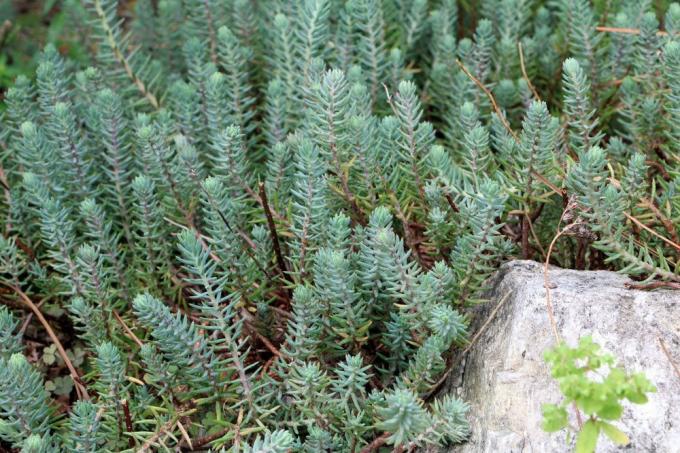
Diseases and pests
The sedum plant is considered to be extremely robust and resilient. Even slugs and other common parasites avoid the diverse plants. Only two problems can occur again and again with Sedum:
Infestation by the vine weevil
Circular feeding spots testify to the presence of this parasite. But the larvae also attack the plants and eat their way through the inside of the leaves. Intensive infestation can therefore even lead to the death of the plant. Insecticides or the use of nematodes, i.e. roundworms as natural enemies of the beetles, promise remedial action.
Root rot
Waterlogging favors putrefactive bacteria in the root area, as a result of which the plant perishes due to the destruction of the roots and the associated insufficient supply. This can be remedied by a drainable soil. Once the rot has set in, damaged areas should be removed and the plant relocated to a drier location.


